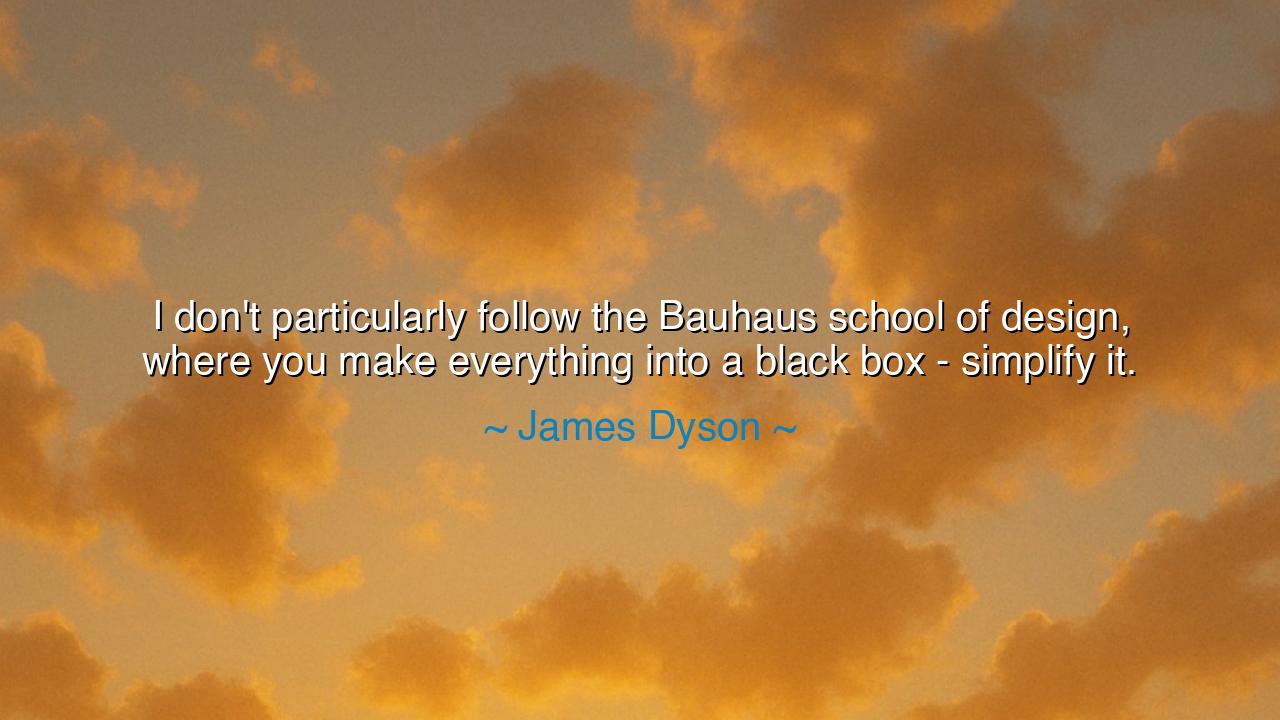
I don't particularly follow the Bauhaus school of design, where
I don't particularly follow the Bauhaus school of design, where you make everything into a black box - simplify it.






“I don’t particularly follow the Bauhaus school of design, where you make everything into a black box — simplify it.” Thus spoke James Dyson, the modern craftsman of air and motion, a man who sees invention not as decoration, but as revelation. In these words, Dyson casts his challenge against an old order—the Bauhaus, the school that once reshaped the 20th century’s vision of beauty through restraint and minimal form. Yet Dyson’s defiance is not rebellion for its own sake; it is the cry of a maker who believes that design must not conceal truth but reveal it, that the beauty of an object lies not in its silence, but in the visible harmony between its function and form.
To understand his meaning, we must first recall the Bauhaus. Founded in 1919 by Walter Gropius, this movement sought to cleanse art of excess and merge craftsmanship with modern industry. It taught that simplicity was purity, that beauty lay in the clean line, the quiet surface, the minimal form. A table, a chair, a lamp—each stripped to its essence, each whispering of order and clarity. The Bauhaus ideal became a gospel for modern design, and its influence spread through every home and city of the modern age. But Dyson, though he honors that lineage, chooses another path. For him, simplification is not the same as truth, and a “black box” that hides its workings is a betrayal of both the maker and the mind that wonders how things work.
Dyson’s machines—his vacuum cleaners, his fans, his hand dryers—do not hide their genius. Their coils, cyclones, and chambers gleam like the organs of a living creature, visible and proud. He invites the user not to observe from afar, but to understand, to see the elegance of engineering made manifest. “Why,” he asks through his craft, “should we hide the wonder of how things function?” In this, his philosophy recalls the inventors and philosophers of old—the Renaissance masters, who saw no divide between beauty and mechanics. Leonardo da Vinci painted and designed alike, believing that art and engineering were twin expressions of divine curiosity. Dyson walks in that same lineage, the lineage of those who reveal rather than conceal.
Consider, too, the parable of the clockmaker’s apprentice. Once, there was a master who built magnificent timepieces, each one a marvel of precision and craft. But his apprentice, eager to follow new trends, began to encase his clocks in smooth, featureless boxes, claiming this was the new ideal of design—clean, simple, efficient. Yet when one broke, no one could mend it, for its workings were hidden. The people soon longed for the old master’s clocks again, whose transparent faces revealed the dance of gears and balance wheels within. Thus it is with Dyson’s philosophy: the visible mechanism is not a flaw but a virtue, for it teaches us how the world moves, how air flows, how innovation breathes.
There is, within Dyson’s words, a greater lesson that extends beyond design. He reminds us that clarity is not achieved by hiding complexity, but by embracing it honestly. Too often, in life as in art, people seek simplicity by masking the intricate truths beneath—by wrapping them in metaphor, pretense, or silence. Yet true mastery lies not in concealment but in transparency. The wise do not fear complexity; they study it, illuminate it, and allow its structure to inspire awe. Dyson’s design, like his thought, teaches that elegance is found in honest function, not in sterile minimalism.
The Bauhaus taught the world to strip away excess; Dyson teaches us to celebrate the inner workings of creation. Where the Bauhaus saw beauty in the pure surface, Dyson sees beauty in motion—the invisible made visible. His machines are symphonies of movement, each curve shaped by the logic of airflow, each detail a dialogue between necessity and imagination. This is not simplification—it is integration, the harmony of purpose and design.
Therefore, let his words be a guide to all who seek to create, whether in art, in craft, or in life itself: do not hide the mechanism of your genius. Show the world your process, your thought, your structure. The pursuit of beauty should never demand the burial of truth. Let your creations be like Dyson’s inventions—transparent in purpose, bold in execution, and fearless in their complexity. For when we design, when we build, when we live with such honesty, we honor not only the function of things but the spirit of creation itself.
And so, in rejecting the “black box,” James Dyson offers a timeless teaching: that simplicity is not the absence of detail, but the presence of understanding. The goal is not to make the world look simpler than it is, but to make its wonders visible—to reveal, through design, the intricate beauty that has always been there, waiting to be seen.






AAdministratorAdministrator
Welcome, honored guests. Please leave a comment, we will respond soon